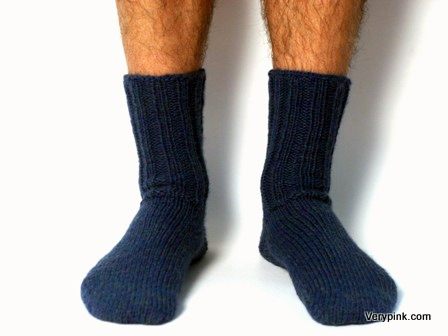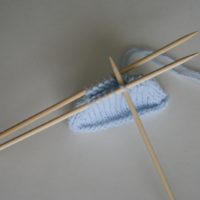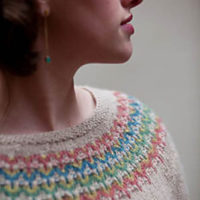
For the first time ever, in sizes for men, women, and kids!
This combination of techniques is such a great way to knit socks, and I’m excited to teach it. First, toe-up is my favorite way to knit socks, because you can use every bit of the yarn with NO LEFTOVERS. Magic loop sock knitting ends up going faster than using double-pointed needles, because you only have to readjust your needles twice in a round, instead of three or four times.
Skill Level: Prior sock knitting experience is helpful. If these are your first attempt at socks, you’ll need strong confidence with basic stitches and pattern reading.
Sizes: Child (5-10 years old), Women, Men (any size, all average widths)
Needles: Size 5 US circular needles with at least a 24” cord
Yarn: 1 skein or hank of worsted-weight yarn (about 100 grams/200 yards) in wool or wool blend. This much yarn will make crew socks in the men’s size (as pictured above), and longer socks in the smaller two sizes.
Additional Materials: Crochet hook in size G or H, scrap yarn, clippie stitch marker, tapestry needle for weaving in ends
Gauge: 5.5 stitches per inch in stockinette
Note on Sizing: The sizing is for average widths, finished sock circumferences 5.75 (7.25, 8)”.
Pattern + links to 5 instructional videos $8 US via PayPal ![]()



Hi Staci – I would like to buy the sock pattern but would like to know if the instructions are only for worsted weight yarn and if so, how easy is it to adapt to fingering weight. I’ve made a couple of pairs of the worsted weight but I really need to use up some fingering weight hanks that I have. I’ve tried following other instructions but yours seem much clearer. Thanks!
Kay – this pattern is for worsted-weight yarn only. Once you knit up a pair in worsted weight and learn the techniques, it is easy to apply what you’ve learned to other sock patterns, that use fingering weight yarn. If you visit my FAQ page under the header “Socks”, you’ll see more info:
https://verypink.com/frequently-asked-questions/
S t a c i
Staci, this is my first pair of socks. I just finished the wrap & turns for the toe. You state in the video that toe up socks are your favorite technique for knitting socks. I spent a lot of time looking at sock patterns and I was overwhelmed by all the different versions of socks. I’m curious to know why you prefer this method.
Jody – I like this method of knitting socks because there is no leftover yarn! Before you start knitting, you can separate your yarn into two equal halves (kitchen scale is helpful). Because you start the sock at the toe, the important part of the sock is knit first. Then you can knit the cuff until the yarn is gone. Perfect!
S t a c i
I have made your Cuff Down Magic Loop socks and love your videos. I realy like the eye of partridge heel but want to make 2 at a time toe up magic loop socks for my 4 and 5 year old Grandsons. Does the above pattern only give instructions with worsted weight yarn and large needles? I have a rainbow sock weight yarn that I want to use but have no idea how many stitches to start with for the toe. Also not sure how many stitches to pick up along side of heel. Would love to buy your pattern if you have one for this size child sock with actual sock yarn.
I’m not experienced enough to figure out number of stitches etc. Please respond soon as possible, am anxious to get started. Thank you.
Sue – please see my Frequently Asked Questions page, under the header “Socks” for answers to your questions, as well as links to free patterns that use sock yarn and smaller needles:
https://verypink.com/frequently-asked-questions/
S t a c i
I have checked those out however they are only for adult socks and I need childs pattern, preferrably toe up. Cannot find anything on the internet, was hoping you had something to get me started at least with number of stitches for the toe.
Sue – I don’t know a kid’s pattern off the top of my head, but you can try this tool: http://www.indigirl.com/sock-app/
S t a c i
Hi Staci
I’m a UK knitter & your worsted weight yarn is our ‘Aran’ weight yarn. That’s fine, I get that. What I don’t get is you ask for US size 5 which are our size 3.75mm – a needle normally associated with DK weight – I would normally use a size up for Aran and looking at the socks in the pattern I just bought they don’t look particularly tightly knitted. Could you explain anything I’m missing? Or am I over-thinking?! : )
Thanks xx
Jo – You can check out my FAQ page for links to yarn weights and needle size conversions:
https://verypink.com/frequently-asked-questions/
Most people get correct gauge (tension) or very close to it, using the size needle I say in the pattern (US 5, 3.75mm). The important thing is that you do use the needle size that gives you the correct gauge I list in the pattern, which is 5.5 stitches per inch. That may require going up or down a needle size.
Hope that helps!
S t a c i
OK – thanks very much for this : )
Hi, Staci,
I just read Joan’s post further up and wondered on the purpose of a gusset, as your toe up methods dont have them and your toe down do.
Is a gusset required and do you have a toe up version that incoporates the “Eye of Partridge” heel?
Many thanks.
Jessi – with or without gusset, short-row or heel flap, these are just all different styles.
To answer your question – no, I don’t have a sock tutorial, toe-up, that uses a heel flap (eye of partridge heel).
S t a c i
How hard would it be to adapt these to two at a time? I want to try the cast on. I have been using Judy’s but thought this gave a more roundish toe. Thanks!
Kay – if you are already comfortable knitting two socks at-a-time, this pattern should lend itself well to that. (It just isn’t taught in the tutorial.)
S t a c i
Hi There!
Two questions…For whatever reason, after I finished turning the heel, my needles are backward…? What I mean is, instead of being able to pull the back needle long, I see to have to pull the front needle long to knit in the round. What did I do to cause this? Secondly, (and this might be super dumb…sorry!), but how do I move my two stitches from one needle to the other when beginning the rib? Thank you for the videos, pattern and instruction! My first sock is turning out great!
Rachel
Rachel – I’m not sure I understand your first question…you should always be able to pull the back needle long. You always want to knit FROM the stitches on the needle in your left hand TO the “empty” needle in your right. If the opposite is true, then you’re “mirror” knitting: https://verypink.com/2012/09/26/backwards-or-mirror-knitting/
Regarding your second question…to transfer stitches from one needle to the other without working them, you just want to slip them over. Put your right needle into the stitch (on the left needle) as if to purl, then slip the stitch to the right needle. Slipping “as if to purl” keeps the stitch from getting twisted.
Hope that helps!
S t a c i
Staci! Thank you so much for this great sock pattern. I’ve got a good handful under my belt and it’s the best pattern I’ve come across. What I love most besides the awesome toe/heel method is it’s adaptability for design and sizing. I’ve given a few pair as gifts and now have “orders” for more. LOL
Happy Knitting,
Carol
Can I purchase the pattern using a credit card and not paypal?
Loved the web site. Anxious to get the pattern.
Sheila – you can purchase my patterns using your credit card, and without a PayPal account. The transaction still goes through PayPal, but they are just a credit card processing company at that point, and you won’t be asked to setup a PayPal account.
S t a c i
Hi is worsted weight yarn Dknin the UK? Sorry but I get confused with the difference thanks Rach xx
Sorry that should read Double knit in the UK but the pad spell checked and said the wrong thing grr
Worsted weight yarn is called “10 ply” in the UK, from what I understand. Here is a link to a yarn weight names conversion chart:
http://en.wikipedia.org/wiki/Yarn_weight
S t a c i
In your toe-up sock pattern it says to pick-up wraps until one stitch remains. Do I pick up the wrap on the last stitch?
Traci – yes…you want to pick up all of the wraps, including the ones on the first and last stitches.
S t a c i
Wow! I just completed my first sock! Something I always wanted to do, but was intimidated by the double points. This was so easy and the video was great. Now on to the 2nd sock and many more pairs!
I would a to make socks using a pattern to learn how to use Magic loop to make the blue one you try to explain on website I can purl and knit can I pay for the pattern with a debit card I would like to do this after having 3 strokes .This will help me I appreciate it
Thank you
Lena
phone 813.428.5787
Florida
Wondering if you have a tutorial or would consider doing one for toe-up two at a time on magic loop. Would love that. Really wanting to try that. I’ve seen other videos, but really enjoy your tutorials.
Thanks,
Katherine
ing
I have bough severeral of your patterns and love them. I purchested your toe up sock pattern do not have the skills to convert it to sock yarn. Do you have a pattern for toe up using sock yarn.
Thanks in advance
Joyce – please see my Frequently Asked Questions page, under the header “Socks” for answers to your question:
https://verypink.com/frequently-asked-questions/
S t a c i
Hi Staci,
I learned very successfully through your tutorials how to make magic loop socks for myself. My husband has a heart problem and suffers with swollen feet and so I am wondering if this pattern would be suitable. Also could I make them longer in the leg? Thank you
Carol – yes, this pattern is sized for both men and women, so there are instructions for socks to fit your husband. You can make the cuffs as long as you like, provided you have enough yarn for it!
S t a c i
Hi Staci,
I am so very happy with all your videos and I would like to purchase the pattern for the Magic loop Socks; my only issue is that I am plus sized, and have found, after knitting my first pair of socks at my LYS class, that they are too small at the instep I also have very high arches) and around the ankle and foot.
My foot is 10″ around the instep and 11 at the ankle and 10.5 inches long–would the men’s sizes here be a decent fit?
Thanks!
Ruth
Ruth – I’m not sure about the inches, but I can tell you this…the woman’s size fits a regular B width, and the men’s size fits a standard D width. Beyond that, any length (shoe size) can be made with either size. Hope that helps!
S t a c i
Hi,
I bought the toe up sock pattern. I want to make a pair of socks for my niece who is a teen. She is a size 10 shoe – what size do I follow?
What about a teen size 10.
Rita – choosing a size in this pattern is based on the foot width, not the shoe size (you can knit the foot any length after choosing the correct width). If your niece’s foot is more like a kid’s foot width, choose the child size. If the width of her foot is more like a standard woman’s B width, choose the woman’s size.
Hope that helps!
S t a c i
Hello,
I’ve just started a trial run of the toe up sock, I’m from New Zealand, and like the writer from Aussie, I’m using 8 ply. Now I have sorted how it works I will get the pattern and see how I go. I have a drawer full of wool to convert. Yipee
Cherie – according to this updated chart: http://en.wikipedia.org/wiki/Yarn_weight
8 ply is DK weight, not worsted weight. There is a chance you’re going to end up with a very loose knit or lacy sock. I recommend using worsted (10 ply) yarn for better results!
S t a c i
I’ve knitted socks with a heel flap before but am converting to more and more with short rows. I can follow the patterns, but I don’t understand what the purpose is of the wraps – what do the wraps do that simply knitting short rows without the flaps wouldn’t do?
Allyson – the wraps in the wrap & turns help eliminate the gap that would occur if you were to turn the work in a short row without the wrap. You can test it out yourself (short rows with and without a wrap) to see for yourself.
S t a c i
Hi Staci, I just bought this pattern, the video tutorial helped immensely! (It’s the second time ever I’ve knitted a sock, so I needed a lot of hand holding.) Thanks so much for your great content, I am stoked with the outcome!
I just purchased the pattern and cannot wait to begin. I have knitted socks before, but never toe-up. Your tutorials are amazing — so easy to follow and understand. Thank you so much. Paula
Hi Stacy, I finally had time over the holidays to use your tutorial and pattern to knit my first socks. I’m already addicted, because it is such a miracle to see the sock take shape! Well, as soon as I finished the worsted socks, I wanted to use some of the beautiful self-patterning sock yarns I’ve been collecting, so I swatched one, 7 stitches per inch, perfect, and used the method of measuring the ball of the foot and deducting 10%, but I didn’t know how many short rows to use for the resulting number of stitches. (24) I re-knit the top of the sock three times because it kept falling into my shoe. Then I realized that the problem is that the heel is too shallow. How do I determine how many short rows to make for different patterns? Can you give us a pattern like the one you provided in this video for fingering weight yarn? I’m not going to reknit this sock again until I know I will get it right … which is very difficult because I am already addicted to sock knitting! Thank you so much for your tutorials!
BTW, as a former professional photographer, I wanted to make a suggestion regarding your videos. I had some problem seeing what you were actually doing with the yarn, and a great deal of trouble seeing what you were doing once you switched to the darker yarn, so I thought I would share the following with you: When you use a camera of any kind that has an automatic light meter, it reads an average of the entire space. If you have a very large white field behind a dark object, it will reflect so much light back at the camera that it will throw off the exposure. The camera will underexpose the entire image to compensate for the large white field, thus making your yarn appear quite a bit darker than it actually is. You will get a much better result if you use a light-medium background, such as a subdued pastel, rather than white. I hope you find this useful!
Aimee – I highly suggest you follow a pattern for socks, especially since you’re a new sock knitter. I use the Universal Toe-Up formula on my fingering weight socks:
http://knitty.com/ISSUEsummer06/PATTuniversalsock.html
S t a c i
Can I use this pattern on magic loop to knit 2 at a time also? I would just repeat the steps and use longer cord length right?
Diann – you can, yes. I also have tutorials and patterns designed to teach two at-a-time. You can see all of my sock tutorials here:
https://verypink.com/category/socks/
S t a c i
Hello,
I just bought the pattern and am really excited to start your videos are great, but the pattern doesn’t have how to work with different sized yarn. In the two toe up video you stated that it does, and I assumed this one did as well. I found the two at a time too advanced for me. Am working with sized one yarn and sized three needles, and I don’t know how many to cast on????. Help please???
Angie – this particular pattern is available for worsted weight yarn only. Most of my patterns and tutorials are designed to teach the skills and techniques you need to knit that item (socks, sweaters, etc.). Once you’ve finished a tutorial, you have what you need to know to move on to all kinds of similar patterns, available in all yarn. I’m sorry – changing the gauge on a pattern is not a quick or simple thing. I encourage you to knit them as written, then use the skills you’ve learned with sock patterns in different gauges.
S t a c i